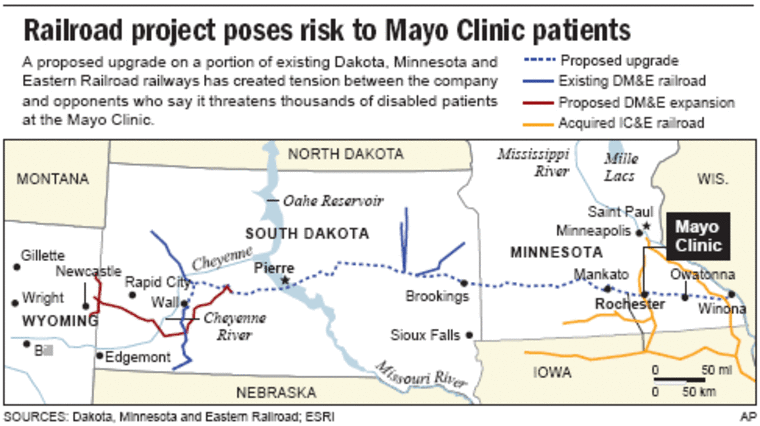Opponents are trying to reroute one of the largest railroad track expansions in a century, claiming it threatens the Mayo Clinic and its patients and staff.
The $6 billion plan would upgrade and extend hundreds of miles of rail lines through Minnesota, South Dakota and Wyoming so they can haul coal to power plants east.
Proponents say the Dakota, Minnesota and Eastern Railroad’s project would bring unprecedented economic development to the region, creating thousands of new jobs.
“This is not an opportunity to come along in a generation. This is an opportunity that comes along maybe once in a state’s history,” said Ted Hustead, president of Wall Drug, a store that has become a tourist attraction with advertisements for hundreds of miles in all directions.
But the rail line would cut within blocks of the Mayo Clinic in Rochester, Minn., the state’s largest private employer. Hospital managers and local government leaders worry about increased rail traffic, noise and the risk of a toxic release if there were a derailment.
Both sides have tried to line up heavy hitters to sway public opinion.
Bill Janklow, a former Republican congressman and governor, has advised project opponents, and former U.S. Senate Democratic Leader Tom Daschle is on the board of the Mayo Clinic, the plan’s major detractor. South Dakota’s current governor and congressional delegation line up solidly behind the project.
Environmental impacts weighed
Both sides are making their cases as the deadline approaches for the public to comment to the federal agency weighing a $2.3 billion loan that is likely essential to the project.
The Federal Railroad Administration will accept public comments on DM&E’s loan application until Tuesday, review them and issue a decision on the project’s environmental aspects. It then has 90 days to approve or deny the loan.
Ken Brown, chairman of the Olmstead County Commission in Rochester, said opponents aren’t against the railroad or the project but just want the railroad to pay for protecting the clinic and city from a catastrophe. “It’s a fairness issue,” he said.
Daschle said he supports the rail line but wants it routed around the city. “There are safety issues and problems involving risks that need to be addressed,” he said.
Kevin Schieffer, president of Sioux Falls-based DM&E, said courts and federal regulators have already addressed safety issues, and that calling for a bypass is effectively an attempt to kill the project.
“People who make that statement know it’s the same thing as opposing the project, but for PR purposes they have to make it sound like they’re not against the project or that they’re not trying to kill the project,” he said.

Coal from Wyoming
The plan involves upgrading 600 miles of aging track and adding about 280 miles of new track to Wyoming’s coal-rich Powder River Basin. The track could also be used for transporting corn-based ethanol and other agricultural products.
Accidents would be far less likely with new track, said Kelby Krabbenhoft, president and CEO of Sioux Valley Health Systems, which has six hospitals and clinics near the DM&E line.
The upgrade would make the railroad safer for the company’s patients and staff, as well as for the public, Krabbenhoft said.
Mayo spokesman Chris Gade noted that the Sioux Valley Health Systems’ hospitals are much smaller than Mayo. “The number of people we treat, the number of staff we have in one concentrated location, is why we’re concerned,” he said.
Some residents in the South Dakota cities of Pierre and Brookings are also not enthused about more, longer and faster trains passing through daily.
Daschle and Dale Larson, president of storm-door maker Larson Mfg. in Brookings, said part of the problem has been the approach of DM&E’s Schieffer.
“The dialogue was one-sided. It was ’my way or the highway’ type of thing,” Larson said. “I’d give Schieffer an A on tenacity and an F on public relations.”
Schieffer said such one-liners don’t jibe with reality. He said he has listened to landowners’ and residents’ concerns at hundreds of meetings.
“The bottom line is, you don’t end up with 55 out of 56 (communities) with agreements by doing the kind of things they are alleging,” he said.
